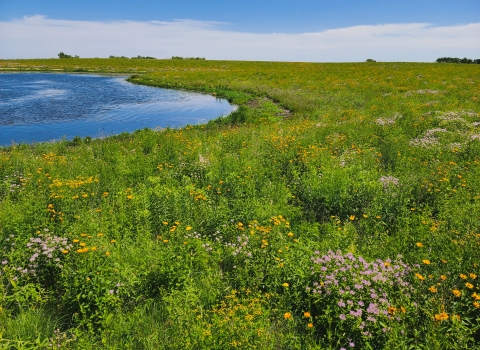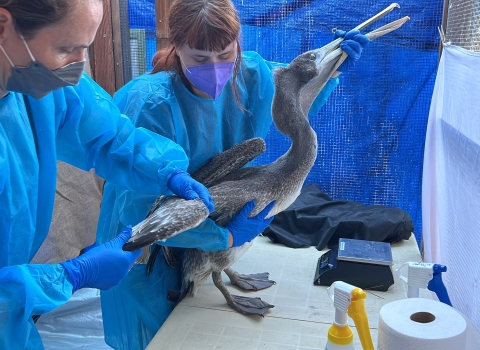LAKEWOOD, Colo. – The western bumble bee, like all bumble bees, is a yellow and black bee that is an important pollinator of a wide variety of flowering plants and agricultural crops in western North America. This bee has a wide geographic range that stretches down the west coast from Alaska to California and reaches as far east as Nebraska and the Dakotas.
This native bumble bee was once widespread and very common, but during the last several decades populations have declined range-wide, particularly in the western, coastal portions of the range.
Defenders of Wildlife petitioned the U.S. Fish and Wildlife Service (Service) to list the bee as threatened or endangered under the Endangered Species Act. The petition claims western bumble bees are at risk from several factors including habitat loss, disease, pesticide use, inadequate protective laws, and climate change climate change
Climate change includes both global warming driven by human-induced emissions of greenhouse gases and the resulting large-scale shifts in weather patterns. Though there have been previous periods of climatic change, since the mid-20th century humans have had an unprecedented impact on Earth's climate system and caused change on a global scale.
Learn more about climate change .
In addition, the Western Area Power Administration has petitioned the Service to remove federal protections for the Deseret milkvetch, which is currently federally-listed as threatened. It is a small perennial herb in the bean family.
The Service recognizes that potential threats from residential development, highway expansion, and livestock grazing have not materialized since it was listed. Surveys also show a higher number, and wider range of plants, than initially thought.
In response to these petitions, the Service is publishing substantial 90-day findings, which is the first step in determining whether species require federal protection, or in the case of Deseret milkvetch, whether federal protections should be removed. A substantial finding triggers a closer look at these species’ status, also known as a 12-month finding to determine whether federal protections, or the removal of such, are warranted. We are asking our partners and the public to send us any information they may have so that we can ensure we make an informed decision on the status of these species.
Other species in this batch found in the Mountain-Prairie Region with substantial 90-day findings include: the American burying beetle (delist), Rio Grande chub (fish), Rio Grande sucker, southwestern willow flycatcher (delist), and the yellow banded bumble bee.
The petition for the Arizona wetsalts tiger beetle was found to be not substantial, and will not receive further study.
The Service is seeking additional scientific and commercial data available on the substantial 90-day findings in this batch. Information is requested by May 16, 2016, and can be submitted electronically at http://www.regulations.gov. In the Search box, enter Docket Number FWS–R6–ES–2016–0023 for the western bumble bee, FWS–R6–ES–2016–0013 for Desert milkvetch, FWS–R2–ES–2016–0011 for American burying beetle (delist), FWS–R2–ES–2016–0019 for Rio Grande chub, FWS–R2–ES–2016–0020 for Rio Grande sucker, FWS-R2-ES-2016-0039 for southwestern willow flycatcher (delist), and FWS–R5–ES–2016–0024 for the yellow banded bumble bee. Then click on the “Comment Now!” button.
Comments can also be submitted via U.S. mail or hand-delivery: Public Comments Processing, Attn: Docket No. [Insert appropriate docket number], U.S. Fish and Wildlife, MS: BPHC, 5275 Leesburg Pike, Falls Church, VA 22041-3803. Please note that submissions merely supporting or opposing a potential listing, without supporting documentation, will not be considered in making a determination.
The Service will post all information received on http://www.regulations.gov. This generally means that the Service will post any personal information that is provided.
To view the complete Federal Register notice that publishes March 15, 2016, visit https://www.federalregister.gov/public-inspection. Click on the 2016 Notices link under Endangered and Threatened Wildlife and Plants.
The mission of the U.S. Fish and Wildlife Service is working with others to conserve, protect, and enhance fish, wildlife, plants, and their habitats for the continuing benefit of the American people. We are both a leader and trusted partner in fish and wildlife conservation, known for our scientific excellence, stewardship of lands and natural resources, dedicated professionals, and commitment to public service.
Connect with our Facebook page at http://www.facebook.com/USFWSMountainPrairie, follow our tweets at http://twitter.com/USFWSMtnPrairie, watch our YouTube Channel at http://www.youtube.com/usfws and download photos from our Flickr page at http://www.flickr.com/photos/usfwsmtnprairie/.


